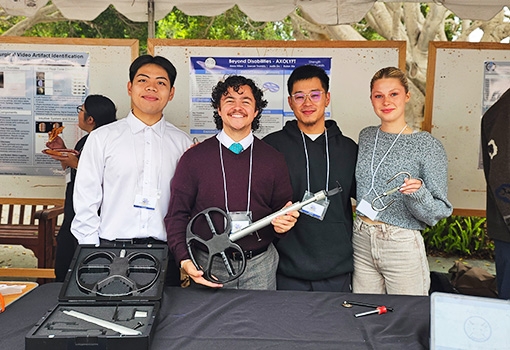by Anchal Sharma
Twenty-nine student teams from The Robert Mehrabian College of Engineering (COE) at UC Santa Barbara showcased their innovative solutions to real-world problems at the 2025 Engineering Design Expo, held outside Campbell Hall on June 6. The event drew a large crowd of faculty, student peers, industry leaders, and the public as students presented and demoed their projects. A panel of COE faculty and industry professionals selected the winning projects in the categories of Electrical Engineering (nine projects), Mechanical Engineering (sixteen), and four “multidisciplinary” teams combining students from Electrical, Mechanical and/or Computer Engineering.
The Capstone Program enables fourth-year engineering students to select a project from a range of ideas proposed by industry sponsors, and challenges them to spend a year — working from ideation and prototyping to final testing and presentation — to solve a real-life problem. The process highlights the COE’s commitment to leverage cross-disciplinary collaboration and strong industry partnerships in preparing students to have real-world impact.
“This year’s class was one of the best I’ve had the pleasure of working with,” said Ilan Ben-Yaacov, a teaching professor in the Electrical & Computer Engineering Department, and a Capstone Program instructor. “We saw so many unique innovations across a wide range of areas, from autonomous vehicles, infrared imaging, aerospace, and medical diagnostic tools, to consumer tech, and AI-powered image recognition, among many others. The students’ creativity and execution were truly impressive.”
In addition to sharpening students’ technical skills, the Capstone experience cultivates essential soft skills. Adailton Nali Junior, a member of the team that created the Hybrid Autonomous Wayfinding Courier (HAWC) — an autonomous delivery system for disaster relief in high-risk, low-infrastructure environments — said that his team’s project was a powerful learning experience in which he gained valuable insights about product development, leadership, negotiation, and the broader business context of engineering work.

Team HAWC (from left to right): Thomas Duan (EE), Daniella Polishchuk (EE), Adailton Nali Junior (EE), Jonathan Du (ME), Akinwole Akinbolagbe (ME), Eliana Nali (EE), Tony Johnson (EE)
“While engineering coursework emphasizes procedural proficiency,” he said, “working in a multidisciplinary team with five electrical- and five mechanical-engineering students showed me that communication, coordination, and team dynamics are just as critical to a project’s success.”
Sponsorship plays a central role in the success of the program, noted Ben-Yaacov, saying, “It takes a village. Our sponsors provide not just the project ideas and funding, but also technical mentorship that offers students real-world simulation.”
Team PulsIR, which won the Excellence in Multidisciplinary Engineering Award, credited their sponsors, Teledyne-FLIR, with guiding them as they developed a handheld diagnostic tool featuring an integrated FLIR Boson+ thermal camera. Designed for clinical use, the device allows doctors to generate thermal maps of a patient’s skin temperature to detect subtle disruptions in blood flow, thus enabling painless, affordable early detection of tumors and diseases such as diabetes.
Cecelia Gant, one of the ten members of PulsIR, noted that the team met with representatives from industry every week to receive mentorship, “Ryan Helling, mechanical engineering manager, provided critical guidance in mechanical design and temperature regulation,” she said, “and Ryan Stevenson, electrical engineering manager, offered expertise in programming, microprocessors, Wi-Fi configuration, and web integration.” The mentors, she added, helped the team shape the project timeline and stay on track while facilitating networking. Beyond technical support, she said, the “two Ryans,” as they came to be known fondly by the team, “also connected the students with appropriate contacts who could offer deeper insight into the workings of Teledyne-Flir’s world-renowned thermal imaging technology.”

Team LITESPEED (left to right): Max Ding (EE), Ee-Ning Ooi (EE), Sean Burke (EE), David Liu (EE), Kim Dang (EE)
The 2025 Capstone Design Expo showcased a spectacular range of student innovation across an impressive array of disciplines. They included Edna Bot, the result of a collaboration with NOAA (National Oceanic and Atmospheric Administration) to create an autonomous ocean-sampling rover for gathering marine data without the need to deploy humans, and Seed Cyclone, a sustainable agricultural solution providing precise seed dispersal with the aim of minimizing weed growth. The AXOLYFT team designed an adaptive accessory to support individuals with physical disabilities, while LiteSpeed developed and implemented an autonomous driving algorithm on a 1/10 scale open-source self-driving vehicle designed for education and research. Find out more about all the teams and their projects.

Team Seed Cyclone (left to right): Hope Karim-Whitt (ME), Wes Gardner (ME), Cae Cox (ME)
Here are the award-winning projects:
Multidisciplinary Engineering
Excellence in Multidisciplinary Engineering: PulsIR (sponsored by Teledyne-FLIR) – an advanced thermal sensing system
Distinguished Technical Achievement: CViSion (Chandrasekaran Lab) – a cutting-edge computer vision platform
Electrical Engineering
Excellence in Electrical Engineering: POGO (ASML) – a precision robotics solution
Distinguished Technical Achievement: radIoQ (HRL) – an innovative radar sensing platform
2025 F1Tenth RoboRacer Champions: ROS2 Raiders – winners of the autonomous racing competition
Mechanical Engineering
Excellence in Mechanical Engineering: Edna Bot (NOAA) – an autonomous ocean-sampling device
Distinguished Technical Achievement: AeroStride (Hawkes Lab, D4H, Cadense) – a wearable assistive mobility system
Most Innovative Design: Seed Cyclone (Cheadle Center) – a novel seed dispersal and planting device
